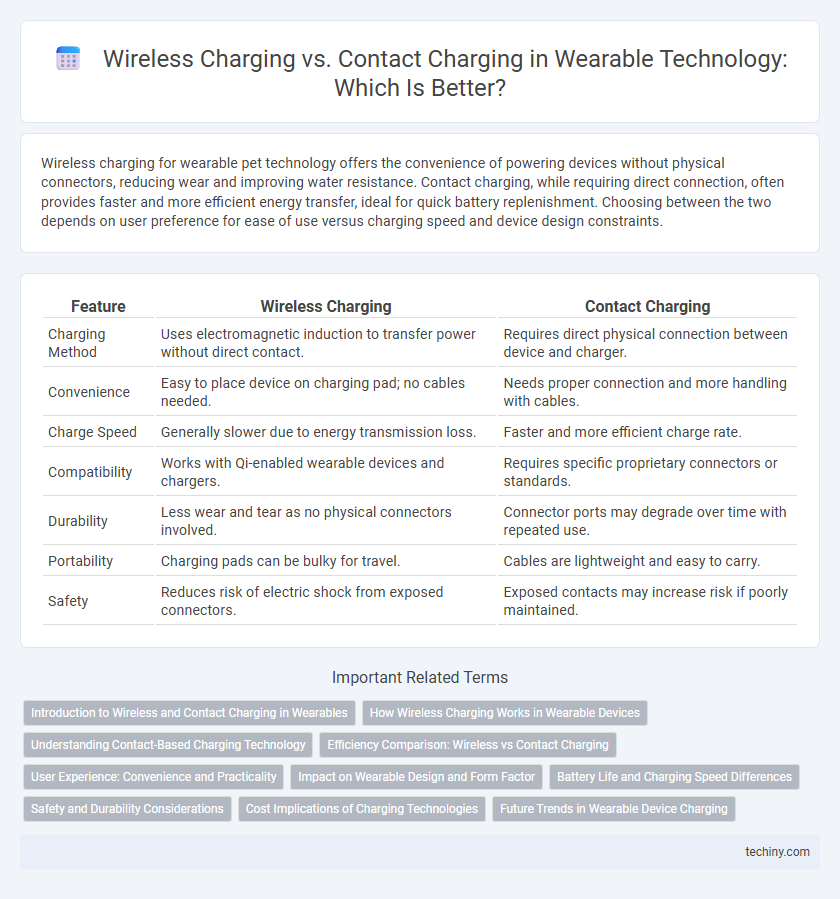Wireless charging for wearable pet technology offers the convenience of powering devices without physical connectors, reducing wear and improving water resistance. Contact charging, while requiring direct connection, often provides faster and more efficient energy transfer, ideal for quick battery replenishment. Choosing between the two depends on user preference for ease of use versus charging speed and device design constraints.
Table of Comparison
| Feature | Wireless Charging | Contact Charging |
|---|---|---|
| Charging Method | Uses electromagnetic induction to transfer power without direct contact. | Requires direct physical connection between device and charger. |
| Convenience | Easy to place device on charging pad; no cables needed. | Needs proper connection and more handling with cables. |
| Charge Speed | Generally slower due to energy transmission loss. | Faster and more efficient charge rate. |
| Compatibility | Works with Qi-enabled wearable devices and chargers. | Requires specific proprietary connectors or standards. |
| Durability | Less wear and tear as no physical connectors involved. | Connector ports may degrade over time with repeated use. |
| Portability | Charging pads can be bulky for travel. | Cables are lightweight and easy to carry. |
| Safety | Reduces risk of electric shock from exposed connectors. | Exposed contacts may increase risk if poorly maintained. |
Introduction to Wireless and Contact Charging in Wearables
Wireless charging in wearable technology utilizes electromagnetic fields to transfer energy without physical connectors, enhancing convenience and reducing wear on devices. Contact charging, relying on direct physical connections, typically offers faster and more efficient power transfer but may suffer from wear and exposure issues. Both methods play crucial roles in powering wearables, with wireless charging leading in user-friendly designs for devices like smartwatches and fitness trackers.
How Wireless Charging Works in Wearable Devices
Wireless charging in wearable devices operates through electromagnetic induction, where an induction coil in the charger generates an alternating magnetic field that induces an electric current in a receiving coil embedded in the wearable. This method eliminates physical connectors, reducing wear and enhancing water resistance. Efficiency depends on coil alignment and distance, with Qi standard being the most widely adopted protocol for seamless wireless power transfer in wearables.
Understanding Contact-Based Charging Technology
Contact-based charging technology in wearable devices utilizes physical connectors or contact pads to transfer power efficiently, ensuring minimal energy loss and faster charging times. Unlike wireless charging, this method provides a direct electrical connection, reducing interference and improving charging stability, which is critical for compact and power-sensitive wearable gadgets. Key innovations in contact-based charging include magnetic connectors and pogo pins, enhancing durability and ease of use for smartwatches and fitness trackers.
Efficiency Comparison: Wireless vs Contact Charging
Wireless charging for wearable technology offers convenient energy transfer through electromagnetic fields but generally exhibits lower efficiency rates, typically around 70-80%, due to energy loss in transmission. Contact charging, relying on direct electrical connections like pins or pads, provides higher efficiency levels often exceeding 90%, resulting in faster and more reliable power delivery. The choice between wireless and contact charging impacts the device's battery life, charging speed, and user experience, with contact charging preferred for performance-critical applications.
User Experience: Convenience and Practicality
Wireless charging offers superior convenience by eliminating cables and enabling effortless power-ups through simple placement on charging pads, enhancing user mobility and reducing clutter. Contact charging, while requiring precise alignment and physical connection, often provides faster charging speeds and more reliable energy transfer, beneficial for users prioritizing efficiency. The overall user experience is shaped by balancing the ease of wireless charging with the consistency and performance of contact charging in various wearable technology scenarios.
Impact on Wearable Design and Form Factor
Wireless charging enables sleeker wearable designs by eliminating the need for exposed charging ports, enhancing water resistance and overall durability. Contact charging requires physical connectors that can limit design flexibility and increase device thickness, impacting user comfort and aesthetic appeal. Advances in wireless charging technology support more compact, lightweight wearables with seamless integration into daily life.
Battery Life and Charging Speed Differences
Wireless charging in wearable technology offers convenience but typically results in slower charging speeds and can generate more heat, potentially reducing battery lifespan over time. Contact charging delivers faster energy transfer with higher efficiency, preserving battery health by minimizing thermal stress. Battery life in wearables is generally better sustained through contact charging due to consistent power delivery and reduced energy loss compared to wireless methods.
Safety and Durability Considerations
Wireless charging for wearable technology enhances safety by eliminating exposed connectors, reducing the risk of electrical short circuits and corrosion, while contact charging can suffer from wear and tear due to repeated plug-in cycles. Durability in wireless chargers is typically higher as they are sealed systems, resistant to dust and moisture penetration, unlike contact chargers which can degrade faster from environmental exposure. Safety standards such as Qi certification ensure both charging methods meet rigorous protection protocols, but wireless charging generally provides superior long-term reliability for wearables.
Cost Implications of Charging Technologies
Wireless charging in wearable technology typically incurs higher initial costs due to specialized coils and circuitry, whereas contact charging systems offer lower upfront expenses with simpler connectors. Over time, wireless charging can lead to increased maintenance costs from wear on charging pads, while contact charging risks connector degradation requiring replacements. Evaluating total cost of ownership includes considering both the durability of charging components and the convenience offered by each technology.
Future Trends in Wearable Device Charging
Future trends in wearable device charging emphasize the shift toward wireless charging technologies due to their convenience and improved user experience. Advanced wireless charging methods like resonant inductive coupling and radio frequency (RF) energy harvesting enable faster, more efficient energy transfer without the need for physical connectors. Innovations in materials and battery efficiency are also driving the development of compact, high-capacity power sources that support seamless, contactless charging for extended wearable device usage.
wireless charging vs contact charging Infographic

 techiny.com
techiny.com